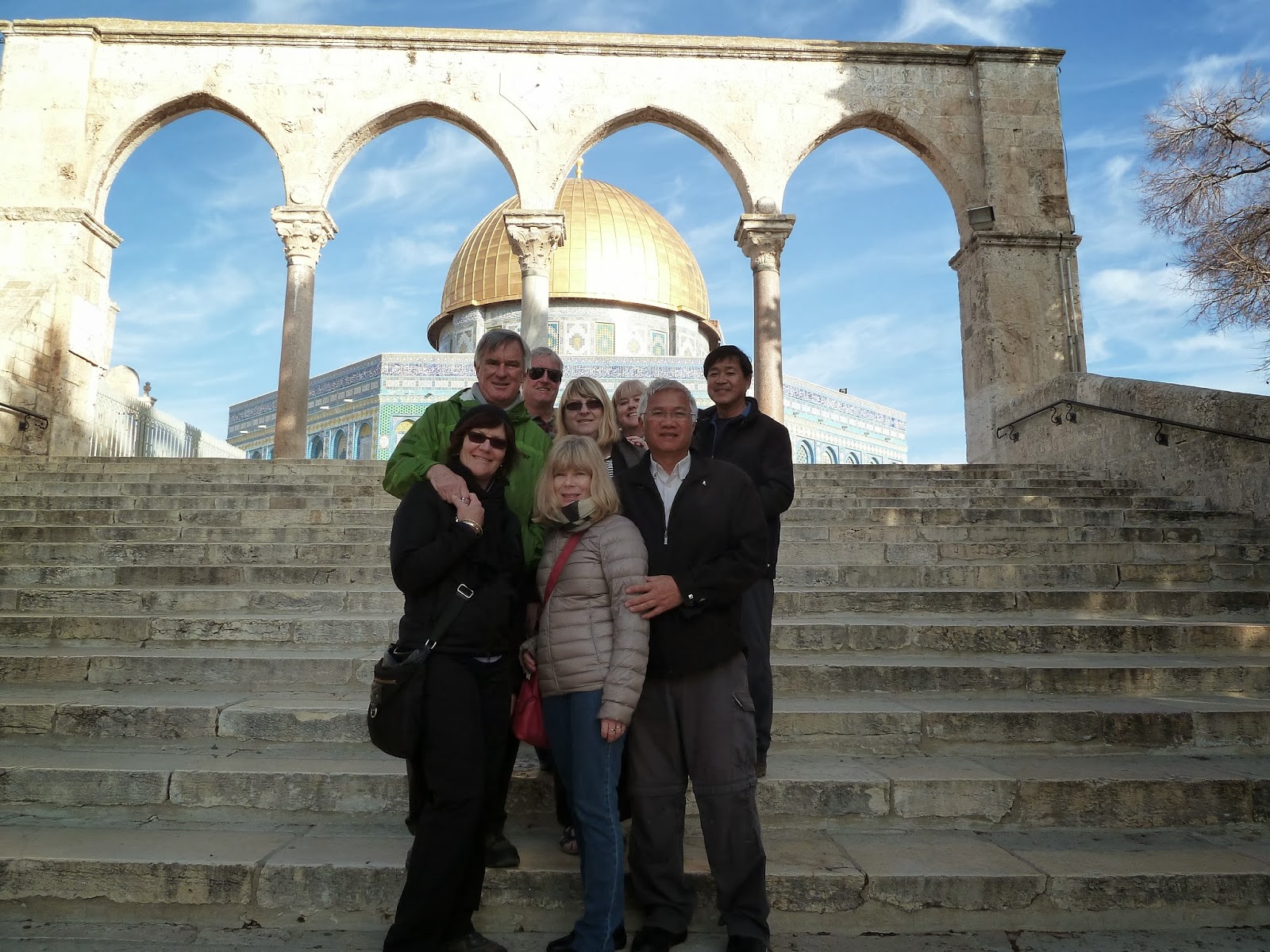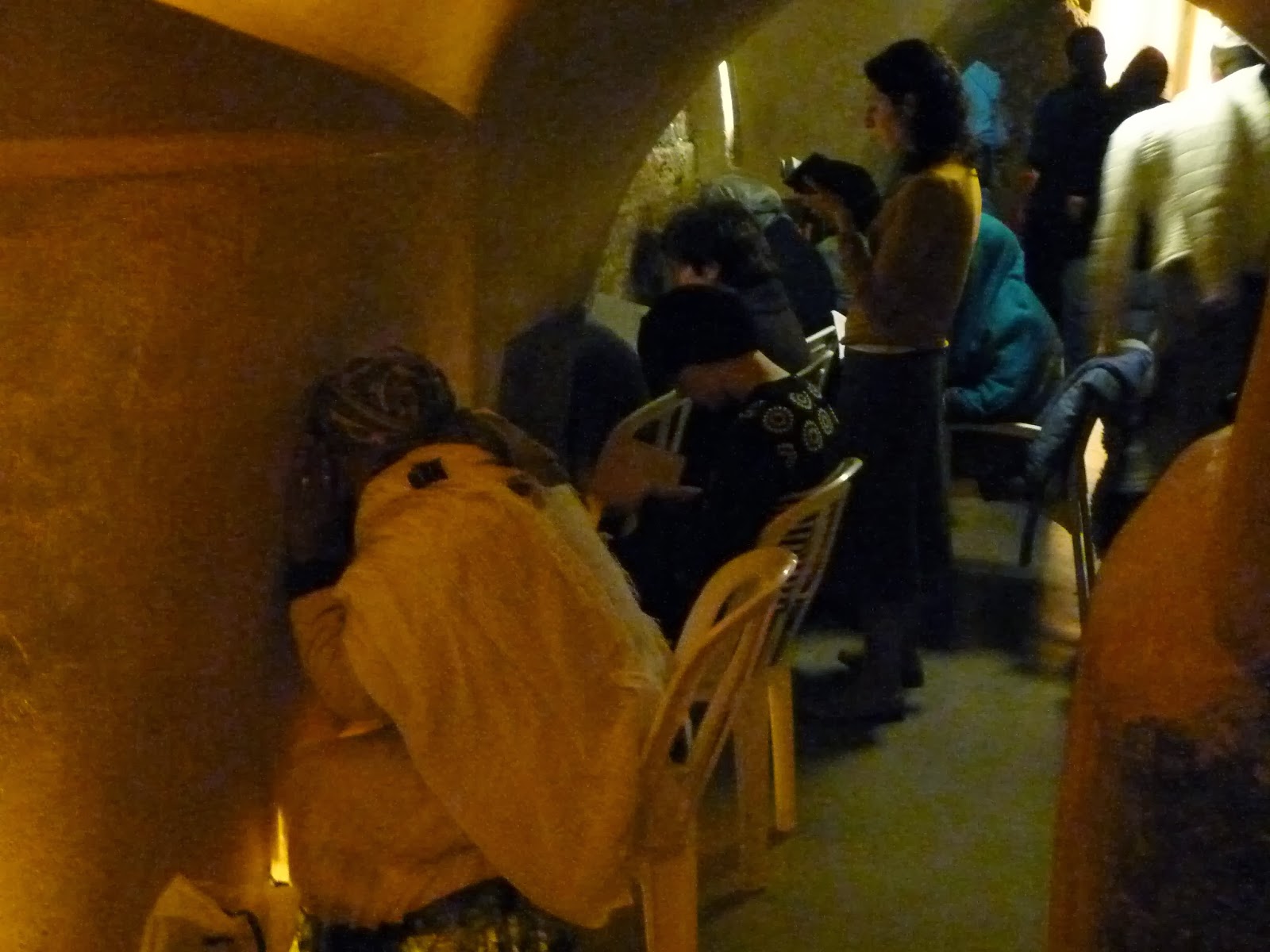We expected that Effie
would drop us at the gate and not come in with us to Temple Mount. But the next
morning he took us in and we found the line quite short. In the line he met a
fellow guide who was being allowed in for the first time in weeks, but had to
have a police guard. He also indicated to some fellow Jews that they would not
be let in as they were carrying prayer mats. We did get in the security gates
quickly and without incident. Once inside we could hear a group of woman
worshippers chanting. Another smaller male group appeared to be chanting in
opposition. Effie indicated that the place was like a tinderbox that didn’t
take much to erupt and something like this could do it. In the end we had time
to have a good look around and take photos in an uncrowded space. We did decide
to leave however when we saw some Police looking to eject someone for nothing
obvious …. It was time to leave and be thankful we got in and out without
incident.
 |
| Muslim temple at Temple Mount |
 |
| Add caption |
The rest of the Old
Jerusalem tour was relaxing in comparison. The tunnels under the Western wall
were amazing. Its still hard to get used to the idea of cities being built on
top of previous cities. We recall Troy having 9 layers. There may have only
been 3 or 4 here but they are still excavating.
 |
| Jews praying in the tunnel at the closest point to Temple Mount |
 |
| Western wall ... closest point for Jews to worship |
I didn’t appreciate the
significance of the Western Wailing Wall being the closet point where the Jews
can reach and pray at their holy site on Temple Mount. We see Jews praying at
the exact point in the tunnels (as well as above the ground on the Western
Wall).
 |
| What's old is new! |
Side-Bar 1 – Social Network Analysis
and Jewish Diaspora
While
walking around this holy city; a complex fusion of religions, nationalities,
cultures and histories I thought about whether network scientists had studied
and contributed to resolving the complex issues that exist here. From a
building communities perspective, I had previously commented that a common
language is the strongest of ‘bonding agents’. Religion would have to be a
close second. A quick Google search uncovered this article:
“Re-thinking Jewish ethnicity through social network analysis” – by
Anna Collar
In Network Analysis in Archaeology : New Approaches to
Regional Interaction
Edited
by Carl Knappett
Basically Collar found that
looking at the Jewish Diaspora as a small world network provides a deeper
insight into how religious innovations diffuse across large networks over time.
She does identify that only strong ties can influence change, the weak ties can
prepare communities for change via information sharing transmissions. Where
weak ties do not exist, the communities become inward looking and parochial.
As we have discovered in other
contexts, the more a community are connected by dense strong ties, the less
likely that the community will be open to change. The religious denominations
are strong tie networks. One does not find people who are both Muslims and
Christians. There are however people who are happy to be open to the views of
multiple religions, but these ‘weak tie’ people are not in a position to
influence change. Perhaps it requires the religious leaders to look for points
of commonality, rather than points of differences if we are to achieve a more
peaceful co-existence between the religious denominations. Interestingly
co-existence of religious denominations was the stated objective of the Jews
for Temple Mount. Weak ties can still be useful for information dissemination
between the denominations, but the denominations have to be open receptors. Our
Jewish guide Effie may have had his prejudices, but to do his job well he had
to become well informed about other religious denominations. Perhaps weak tie linkers
educated like Effie could play an important role in brokering at least a
tolerance of religious differences. Perhaps the network scientists can
contribute something here.
Back to the Jewish Diaspora ….
arguably the largest network of its type, network science definitely has a role
to play in sustaining and improving its connectedness. We have already had discussions with
the CEO of an Australian Diaspora network on this very topic. …. more on this
tomorrow.
Side-Bar 2 – How do a group of engineers entertain themselves while
their wives are shopping?
The initial context is browsing
archaeological artefacts in a shop in Old Jerusalem. We sit in on the pitch to
our wives on the ‘must have’ artefacts for their display cabinets. First the
coins come out and here is the half shekel coin that it cost to enter the
Temple in the time of Jesus. Selling for the bargain price of $300 or say 1,000 Shekels. So is this an
unreasonably high price? Well not if you apply compounding interest calculations
amortized over 2,000 years …. 219,643,102.52 Shekels, so one would suggest that 1,000
shekels is a real bargain. But in reality its just a coin, rather than a piece
of legal tender. Its value is intangible (or that is at least what one of the
wives argued). So obviously using a compounding interest formula is not
realistic. We need to look at the equivalent buying power. In the time of Jesus
a half shekel could buy a cow. So how much does a cow sell for today? Well
according to Yahoo Answers about $2,000 or say 6,200 Shekels … so still a
bargain … well maybe not …but we did use up a good hour discussing this. Julie
purchased a 2,000 year old oil lamp for much less than a cow!
Geoff in our group uses computer
simulations to assess things like coal loading facility capacities, which
include waiting times. I decided to challenge him to predict how long we would
need to wait when 4 women enter a shop together? Now if it is just one woman,
say my wife, I can take an average time over a series of shops of different
types…pretty straight forward. But what happens when four women enter a shop
together? It unlikely to be 4 times the average waiting time for one….you do
get some economy of scale efficiencies. But Geoff baulked at estimating the
interaction effects. Group buying decisions can actually negate these
efficiencies, especially if all parties are not in agreement. As a network
scientist I know that the larger the community the longer it will take to gain
a consensus, but this can be significantly impacted by the level of trust and
reciprocity in the group….which we believe exists in this case, so we are
hopeful that the group wait time may be at the lower end of the range. So
tentatively we come up with
 |
| Someone else's attempt at calculating the Shekel's appreciated value over 2,000 years |
Wt = N*T1/F
Where Wt =
Predicted Wait Time
N
= number of women in group
T = mean time for a single one woman visit
F = Fudge Factor for Group Trust
No comments:
Post a Comment